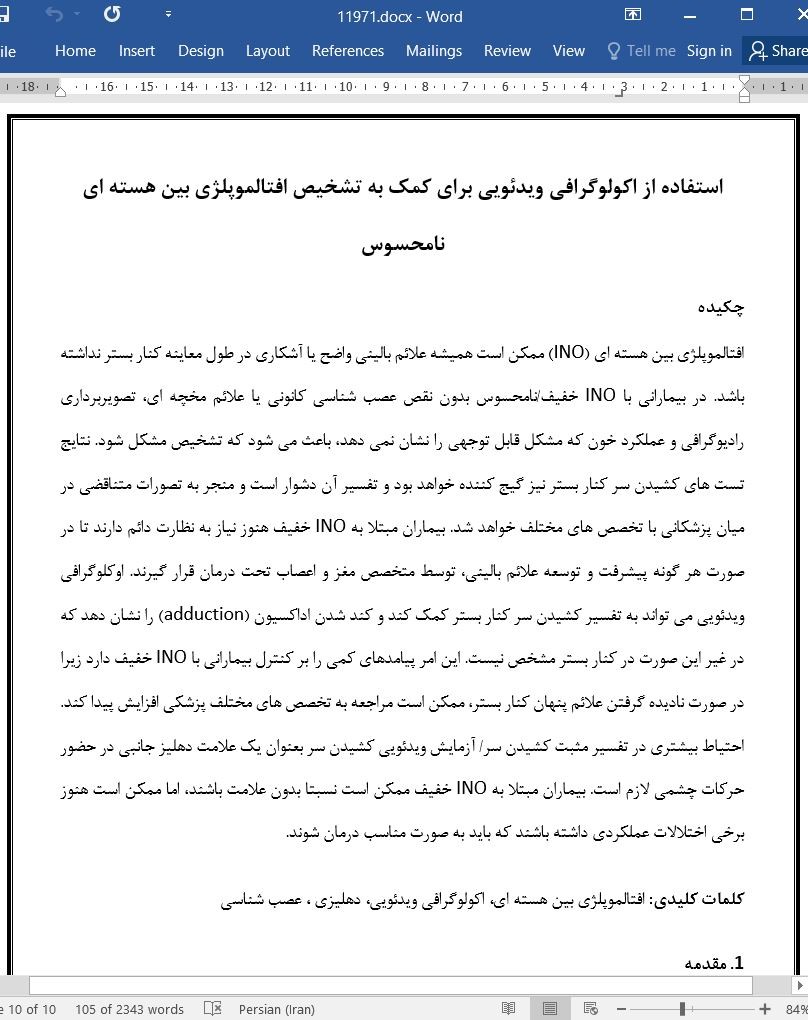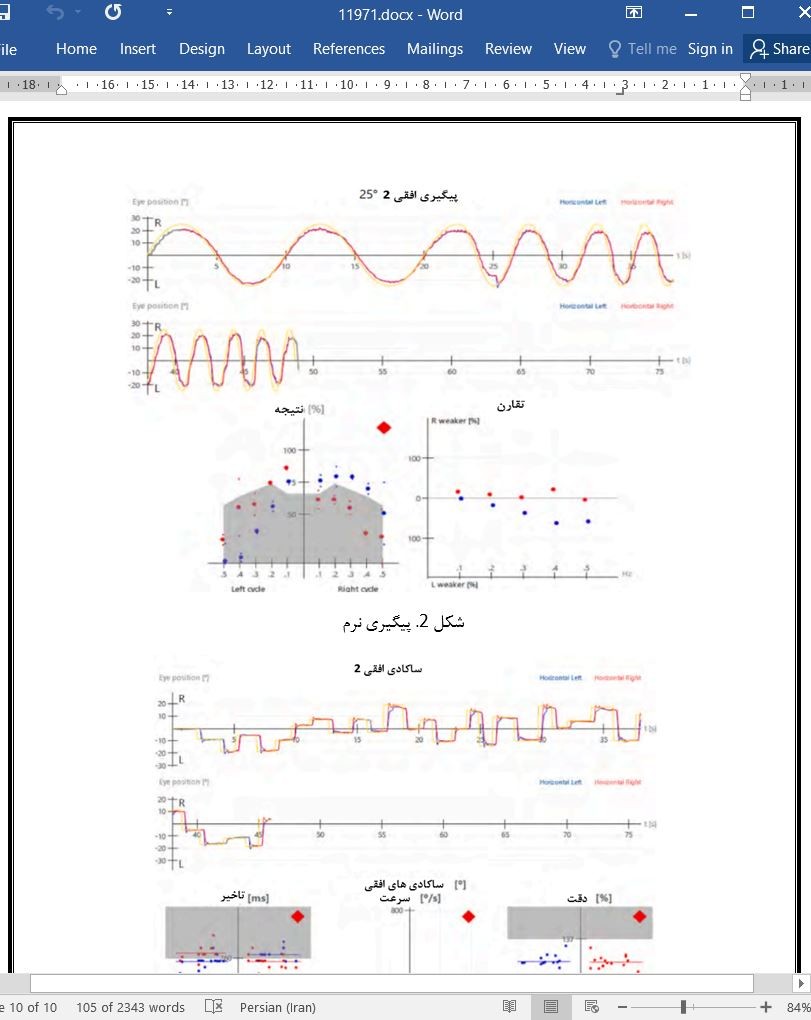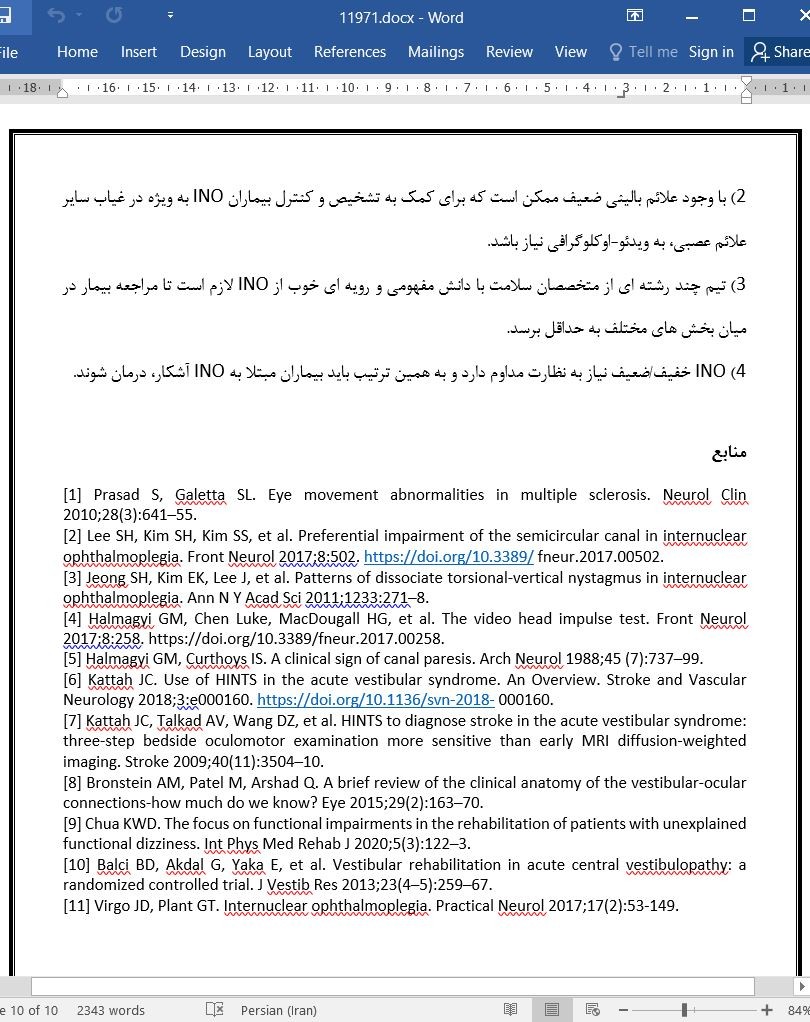
استفاده از اکولوگرافی ویدئویی برای کمک به تشخیص افتالموپلژی بین هسته ای نامحسوس
چکیده
افتالموپلژی بین هسته ای (INO) ممکن است همیشه علائم بالینی واضح یا آشکاری در طول معاینه کنار بستر نداشته باشد. در بیمارانی با INO خفیف/نامحسوس بدون نقص عصب شناسی کانونی یا علائم مخچه ای، تصویربرداری رادیوگرافی و عملکرد خون که مشکل قابل توجهی را نشان نمی دهد، باعث می شود که تشخیص مشکل شود. نتایج تست های کشیدن سر کنار بستر نیز گیج کننده خواهد بود و تفسیر آن دشوار است و منجر به تصورات متناقضی در میان پزشکانی با تخصص های مختلف خواهد شد. بیماران مبتلا به INO خفیف هنوز نیاز به نظارت دائم دارند تا در صورت هر گونه پیشرفت و توسعه علائم بالینی، توسط متخصص مغز و اعصاب تحت درمان قرار گیرند. اوکلوگرافی ویدئویی می تواند به تفسیر کشیدن سر کنار بستر کمک کند و کند شدن اداکسیون (adduction) را نشان دهد که در غیر این صورت در کنار بستر مشخص نیست. این امر پیامدهای کمی را بر کنترل بیمارانی با INO خفیف دارد زیرا در صورت نادیده گرفتن علائم پنهان کنار بستر، ممکن است مراجعه به تخصص های مختلف پزشکی افزایش پیدا کند. احتیاط بیشتری در تفسیر مثبت کشیدن سر/ آزمایش ویدئویی کشیدن سر بعنوان یک علامت دهلیز جانبی در حضور حرکات چشمی لازم است. بیماران مبتلا به INO خفیف ممکن است نسبتا بدون علامت باشند، اما ممکن است هنوز برخی اختلالات عملکردی داشته باشند که باید به صورت مناسب درمان شوند.
5. مردمک چشم بالینی
1)هنگامی که نیستاگموس یا حرکات چشمی قطع شود، با احتیاط می توان کشیدن سر کنار بستر را بعنوان یک علامت محیطی تفسیر کرد.
2) با وجود علائم بالینی ضعیف ممکن است که برای کمک به تشخیص و کنترل بیماران INO به ویژه در غیاب سایر علائم عصبی، به ویدئو-اوکلوگرافی نیاز باشد.
3) تیم چند رشته ای از متخصصان سلامت با دانش مفهومی و رویه ای خوب از INO لازم است تا مراجعه بیمار در میان بخش های مختلف به حداقل برسد.
4) INO خفیف/ضعیف نیاز به نظارت مداوم دارد و به همین ترتیب باید بیماران مبتلا به INO آشکار، درمان شوند.
Abstract
Inter-nuclear ophthalmoplegia (INO) may not always have overt or obvious clinical signs during bedside examination. In patients presenting with mild/subtle INO with no focal neurological deficits or cerebellar signs, an unremarkable radiographic imaging and blood work, diagnosis will be challenging. Results of bedside head thrust tests will also be confounded and difficult to interpret, leading to discordant impressions among physicians of different specialties. Patients with mild INO will still require active surveillance to watch for any progression and development of clinical signs and should be managed by neuro-ophthalmology specialty. Video-oculography can assist with the interpretation of bedside head thrust and reveal slowing of adduction that is otherwise not obvious bedside. This has downstream implications on the management of patients with mild INO as they may be “volleyed” among different medical specialties if covert bedside signs are overlooked. Greater caution is needed on interpreting positive head thrust/video head impulse test as a peripheral vestibular sign in the presence of disconjugate oculomotor movements. Patients with mild INO may be relatively asymptomatic but may still have some functional impairments that should be addressed appropriately.
5. Clinical PEARL
1) Interpret bedside head thrust with caution as a peripheral sign when nystagmus or eye movements are disconjugate.
2) Subtle clinical signs may require video-oculography to assist in the diagnosis and management of INO patients especially in the absence of other neurological signs.
3) Multi-disciplinary team of health professionals needed with good conceptual and procedural knowledge of INO needed to minimize “patient volleying” among departments.
4) Mild/subtle INO requires active surveillance and should be treated similarly to patients with overt INO.
چکیده
1. مقدمه
2. مطالعه موردی
2.1. اوکولوگرافی ویدئویی
3. بحث
4. نتیجه گیری
5. مردمک چشم بالینی
منابع
Abstract
1. Introduction
2. Case study
2.1. Video-oculography
3. Discussion
4. Conclusion
5. Clinical PEARL
Funding
Ethical statement
Declaration of competing interest
Acknowledgement
References
- اصل مقاله انگلیسی با فرمت ورد (word) با قابلیت ویرایش
- ترجمه فارسی مقاله با فرمت ورد (word) با قابلیت ویرایش، بدون آرم سایت ای ترجمه
- ترجمه فارسی مقاله با فرمت pdf، بدون آرم سایت ای ترجمه



